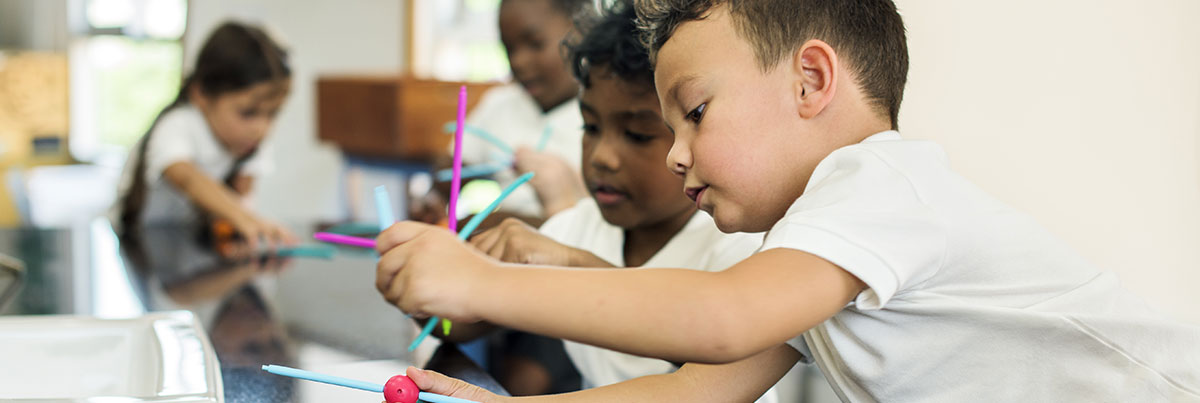A simple graphic design term has consumed my thinking during teaching and coaching at a distance: negative space. It’s something I first read about in White Space Is Not Your Enemy (Golimbisky & Hagen, 2010), a title derived from a single, pertinent rule of design: empty space matters. That’s because the “empty” portions of images are not empty at all. These empty, or negative, spaces without text or images are what “help guide the viewer’s eye through the flow of the design.” (p. 37)

The negative space surrounding images tells us where to look.
So many months into distance-schooling, this simple rule of design makes an easy leap to metaphor: in teaching and instructional coaching, negative space matters.
Negative space is all the “other stuff” we pay attention to when we interact with students. It’s their body language, their tone of voice, where and when their eyes drift during practice and instruction. It’s the conversations they’re having with friends as they walk through the door. These cues are essential to help teachers connect with learners, and shape the small moment-to-moment moves that make a classroom hum. In my view from teaching at a distance, that negative space has never been more absent.
I began this school year at a new school, teaching a new class, from my living room. My students, all high school English Learners who I had never met before, began the school year quietly, and often invisibly, as they Zoomed in and out their daily synchronous virtual classes. The negative space I so frequently rely on to make connections with students- doodles on their backpacks, snickers at my corny jokes, facial expressions, who they’re chatting with as they walk into the room- did not accompany my teenagers into our virtual space.
My experience is not unique; in August the U.S. Census Bureau reported that 93% of households with school-age children participated in some form of distance learning. In the springtime, when schools abruptly closed, many districts re-opened as virtual classrooms, to students who knew their teachers and vice versa. This fall, however, teachers across the nation opened their virtual doors to young people they had never met and might not ever see.
In an interview with Brene Brown, writer Priya Parker describes the “disproportionate power of the mute button” as a contender we now must consider in virtual gatherings. It’s true. If students don’t want to show themselves or speak in a virtual setting, we can’t force them to do so. Many of the secondary teachers I work with report a familiar struggle: when students refuse to be seen or heard, it’s hard to know if they’re with us.
If there was an easy trick to materialize all the negative space, or “soft information”, we’d be doing it already. In the absence of an easy solution, it’s worth taking pause to name why what we can’t see is important. Student-to-teacher feedback and students’ sense of belonging are two vital elements of learning that are affected when we lose the negative space that our students usually bring with them.
STUDENT-TO-TEACHER FEEDBACK
In my work with teacher teams, we explore the research behind how and why to create a classroom culture that is rife with feedback for students. John Hattie’s Visible Learning research confirms that feedback that is right on time, and right on target, can double the rate of learning (Hattie, 2012). But what the research also reveals is the power of feedback that students give to their teacher. This valuable input can “make visible” the points of confusion, or points of interest, that inform a teacher’s next moves. Student-to-teacher feedback, writes Hattie, “is our starting point when determining the nature of our subsequent feedback to them,” (2018).

We need their feedback just as much as they need ours.
Now, with the value student-to-teacher feedback in mind, consider this: Our brains process visuals 60,000 times faster than text. Consider the observational data that teachers typically process, just by looking around the room. When half the class slumped in their chairs, losing interest, teachers know they need to throw in a quick joke or a brain break. When the quietest students are scribbling down notes, we can see that they are with us even if they don’t volunteer to join the class discussion. This is timely, specific feedback that teachers utilize to inform their work during lessons. We process that information at lightning speed.
In a distance learning scenario, there are still numerous ways we can solicit feedback from our students- but few yield the same immediacy as a quick look around the room. Feedback in the form of chats, exit tickets, and surveys are informative for students to articulate, and for teachers to review. However, I want to name what’s missing when we can’t gather quick, nonverbal information from our students. The effectiveness of student-teacher-feedback is limited to asking the right questions and depending on all students- even the reluctant ones- to put forth their most honest answers. It also requires that the teacher, already at maximum cognitive load from the demands of pandemic teaching, reads and processes students’ responses. Sometimes that can be done quickly, and in other situations it requires considerable time.
The value of what we can easily garner when we read the room for “negative space” is not to be taken for granted.
BELONGING
Beyond informing instruction, negative space- what is communicated without saying anything- is essential to foster students’ sense of belonging. I have watched my own elementary-aged children proudly show their favorite toys to their class on virtual “share day”. In those endearing K-2 classes, students know what their classmates look like, and even what their living rooms look like. They watch each other sing along or struggle together with a math problem. This is not strictly academic information; what they take in when they see and do with their classmates signals that they belong together in the group.

High school students in my class, on the other hand, tend to hide their faces even when their cameras are on. Instead of discussion, they are more likely to send a chat privately or keep their comments to themselves altogether. This halts to the momentum of a class flow, but more importantly, it prohibits connection between students.
A November article in the New York Times cited a survey that revealed more than a quarter of teens felt disconnected from adults and peers at their school. Consequently, the nation is seeing an increase of young people in emergency rooms with mental health emergencies. In a virtual space, teens don’t necessarily see all the “other stuff”- the negative space- surrounding their peers that would normally give them something with which to build a bond. The result is a mental sense of isolation that is exacerbated by their physical isolation.
I would argue that this is not for teachers’ lack of trying. The adage, “They won’t care what you know until they know that you care,” has been circulating among educators for years. Teachers want their students to feel like they belong. We want to notice their haircuts, we want them to find out what they have in common with classmates, to feel empowered to bring their most authentic selves to class. It’s hard to coax this out of a group of learners who, when given the choice, will choose silence over vulnerability any day.
Creating a sense of belonging feels right as humans, and it has academic implications as well. Floyd Cobb, in referencing Maslow’s hierarchy of needs, writes, “Maslow’s point is that we need to belong in order to achieve. Our self-worth rises when we are grounded in community.” (2019) In other words, students need to feel like they are an important part of their community in order to fully realize their academic potential. If the years ahead reveal significant drops in student achievement, we will need to consider it an impact not only of learning lost due to wifi connectivity, but also a population starved of authentic connections with teachers and peers.
When every member of a community is silent and represented only by a name in the bottom of a dark, vacant box, it requires significant imagination to ground oneself as an important member of the group. The “empty” space of a reciprocated smile or a favorite band that could normally be students’ entryway into belonging, is on mute.
As with so many problems, the first step to a solution is naming what we’re dealing with. In naming what is lost when we lack negative space, perhaps we could nudge ourselves to examine what we, as teachers, are holding ourselves accountable for- and what things are ultimately out of our control. Better yet, perhaps it can present a clear angle for creative approaches. We need every bit of feedback students can give us, and they need to know that they belong. Resilient teachers and students are showing daily that they will keep coming to school while we learn how to do best by each other. That, I’d say, is a positive.
References/for further reading:
Cobb, Floyd, and John Krownapple. Belonging through a Culture of Dignity: the Keys to Successful Equity Implementation. Mimi & Todd Press, 2019.
Goldberg, Emma. “Teens in Covid Isolation: ‘I Felt Like I Was Suffocating’.” The New York Times, 12 Nov. 2020, www.nytimes.com/2020/11/12/health/covid-teenagers-mental-health.html.
Hattie, John. Visible learning for teachers : maximizing impact on learning. Routledge, 2012.
Hattie, John. and Clarke, Shirley. Visible Learning: Feedback. Routledge, 2019.
“Imagery Vs. Text: Which One Does The Brain Prefer?” World Of Learning, www.learnevents.com/blog/2015/09/07/imagery-vs-text-which-does-the-brain-prefer/.
Trafton, Anne. “In the Blink of an Eye.” MIT News | Massachusetts Institute of Technology, news.mit.edu/2014/in-the-blink-of-an-eye-0116.


